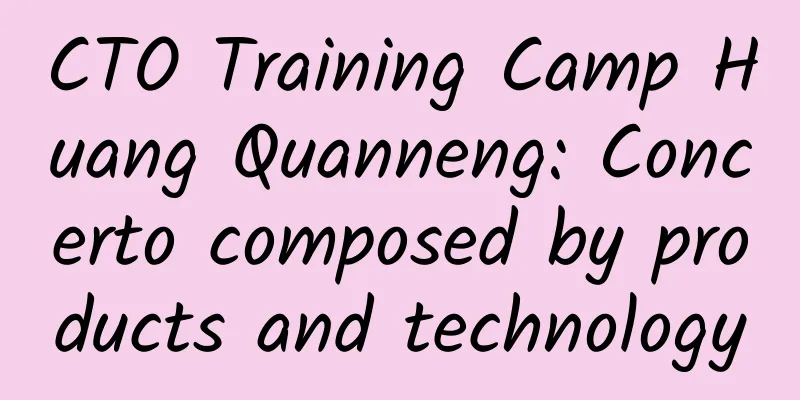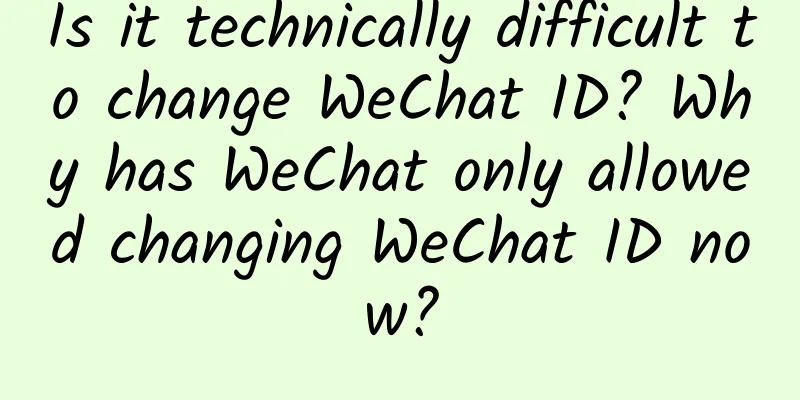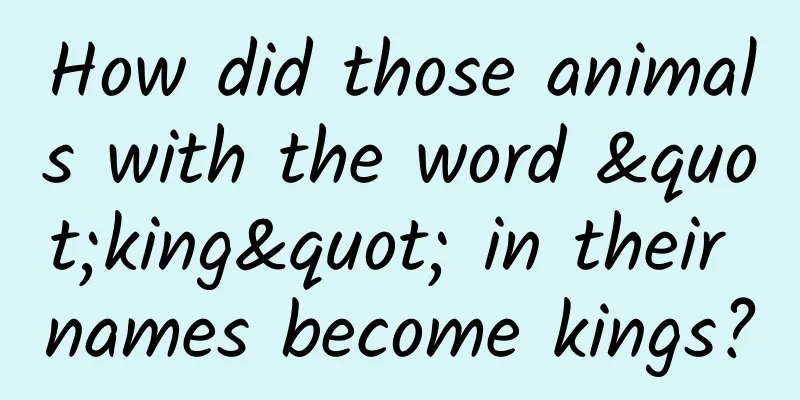CTO Training Camp Huang Quanneng: Concerto composed by products and technology

|
Huang Quanneng, technical director of Changba, shared his thoughts on the theme of "The Concerto of Products and Technology" at the "CTO Training Camp Fifth Lesson: The Art of Management" hosted by 51CTO Gaozhao. The content mainly introduced the relationship between products and technology, and how to resolve the contradiction between the two. Lecturer Profile Huang Quanneng, technical director of Changba, joined Ericsson after graduating from Tsinghua University in 2005. Five years later, he joined a Silicon Valley cloud computing company as the head of the business intelligence group. He joined Changba in 2012 and is now the technical director of Changba's online R&D department. In the process of Changba's technical team from 0 to 1, he used the small but fine team management concept and the elite and unexpected bonus management methods, which made the technical team famous for its strong cohesion. The relationship between technology and products is a cooperative one. Products are designed and technology is used to build them. However, products and technology are inherently in an antagonistic relationship, with one being a consumer and the other being a producer. So when something is produced but consumption cannot keep up, the product will feel that the technology is not strong enough; when technology produces something that is difficult to sell or use, technology will feel that the product design is not good. This kind of opposition often occurs. Some product design solutions are difficult to implement technically, and the product will feel that the technology is too poor, while technology will say that the design is unreasonable. Sometimes a balance is struck between the two in terms of demand. However, when it comes to operations and marketing activities, products and technology are in a mutually supportive relationship. Huang Quanneng believes that the following points can help products and technologies to work together: Technology needs to understand product direction Some companies really treat technology as an outsourced team, similar to a construction team. They will do whatever the product indicates, but in fact, the product direction is important to the morale of employees. If there is no communication between the product and technology, and the technology is not told the direction, the technology will not be able to see the significance of the product. Secondly, in terms of code architecture, the product direction may not be well thought out by the developer. At this confused stage, the developer has no idea how to build the database, interface, and architecture. *** is technical reserve. Many times, products are not launched in a hurry because they know that the technology may not be completed at this stage and the technical reserve is not ready. However, if the technical staff does not understand the product direction, they will also say that the product has not yet raised the demand and can do some small optimization instead of investing in more front-end development. A large part of the technical responsibility is to communicate with the product direction and plan the route for your own technology. Technical learning requires direction, so it is very important to understand the product direction. Technology should understand product details In addition to understanding the direction, there should also be a document that fully records the interaction between the product and technology, also known as product details. As a technology, some small details really need to be well controlled, and the reasons are actually the following three points. The first is the choice of architecture. Because the direction has been determined, although the details will have a smaller impact on the architecture, they may actually affect the processing of some animations, including the display of some layers. If you don't pay attention to the details, you won't guess which direction the product will change. The same is true for API interfaces. For some APIs, the details will actually affect the interaction with the server, and the server will affect how to store, cache and other things, which may all be handled. The second is the quality of the product. IOS and Android need to interact in many places, and sometimes there will be inconsistencies, including testing, which is also done by testing Android on Android and IOS on IOS. If there is no large-scale testing, some inconsistencies will appear. The product manager may start with the big functions, and may not see problems in some small interactions or systems, which will lead to some small problems in product quality. If the technology cannot understand the details, there is no way to cover up the product, and it is very likely that some small, unhandled problems will pop up, such as the error prompt that should pop up does not pop up, etc. The third is the product bug. If you don't understand the product details at the beginning, this problem will often occur. When the product itself is very complicated and the product manager is not very familiar with the entire product, there are basically three situations. The first is the loss of function. The next version changes the previous version in a different way, but loses a small part of the function and does not complete it. Or the page is inconsistent and the style is changed to display. There are also some logical contradictions. For example, after the account is blocked, the user can still post comments from other places. Product bugs like this need someone to maintain. Technology should understand product difficulties Technology must pay attention to the product and know what the product thinks. When technology feels that it is inconsistent with the product's ideas or the product will cause difficulties for technology, or even for non-technical business, these things must be pointed out in a timely manner. Changba's technology will directly challenge some of the product's ideas, designs, and requirements, including why it is done this way. Although it is easy to draw swords at this time, how to avoid crossfire is actually to understand each other. Part of this understanding is that technology has to understand some of the difficulties of the product. The biggest difference between products and technology is that products are highly subjective. Not all products can be driven digitally; some products cannot be judged by AB testing. Therefore, we must consciously understand certain speculations about the product and reduce unfounded provocations. In addition to subjectivity, there is also trial and error. Sometimes the product itself does not know whether the subjective imagination is good or not. We should allow a certain trial and error of the product and provide a trial and error cycle. We should cooperate in technology and provide flexible solutions as much as possible; some ideas may make sense in the early stage, but will quickly become outdated. Technology should drive product progress In some companies, products are the result of communication between product managers and their internal teams. Technology should recognize which aspects of the product can be challenged. Subjective products are prone to adding too much; products will continue to add this kind of trial and error, wasting the cost of trial and error; rough design will affect product quality. The cost of trial and error is actually very high. One is the user cost. If the solution is not good, it will lead to user loss. Another is the opportunity cost. When doing other things during iteration, the users who should come in do not come in, and the users who should be retained are not retained. Then there is the R&D cost. A large amount of development cost and maintenance cost are very important. You cannot be completely subjective and cannot try and error completely. As for the rough design affecting product quality, this must be made clear to the product manager. Many products think that not many users care if the product is a little rough, but in fact, the roughness of the product design can not only affect the architecture, but also various strange states, various hack displays, various unnecessary server pressures, and affect the code style. Technology should monitor product issues Product managers are often lonely. At this time, technical development and testing of the same module can become the allies of product managers. Technology should proactively collect data, add statistics, and embed logs. Build trust between technology and products Give both parties the opportunity to establish a balance of power that suits the strength of their own company team. There can be two systems: the product manager's prestige evaluation system and the technical partner's ability evaluation system, which score the situation between products and technology respectively. In fact, it is difficult for product managers to make KPIs, because the comprehensive evaluation of product managers is difficult to quantify so clearly, and it is more about looking at what the situation will be after the product iteration. Build a technical team with a product perspective If you want to build technology with a product perspective, the technology must meet at least three points. The overall situation, be prepared for the future possibilities of the product; logic, discover product bugs, dare to question the direction of the product; initiative, proactively reserve some functions to fill the gaps in the product. There is also a plus point, aesthetics, good technology has a natural appreciation and understanding of beauty. Good technology pursues clean, complete and extensible code architecture, and also has its own views on the product. Establish a healthy workflow Give the product enough space and build appropriate firewalls, but make sure the product conveys its intentions and solves the problem for the technology. Establish a feedback mechanism for technology and products 【Editor's recommendation】
|
<<: Which one is the million-dollar luxury car you can experience?
>>: Here are all the contents related to China in the report of the Queen of Internet
Recommend
Second-hand trading website advises selling old iPhone as soon as possible
Gazelle, a well-known second-hand electronic cons...
Dingdong Maicai Product Analysis
The fresh food e-commerce industry is also an ind...
How to effectively reduce user churn?
Like running a marriage. We gradually get used to...
Some are happy, some are sad, there are big winners on 315, 3 mobile phone manufacturers do a good job in privacy protection
Every year, March 15 becomes a nightmare for busi...
How to use zero-threshold oCPC delivery?
Baidu's zero-threshold oCPC has been online f...
Koi, showing off wealth and falling down... Analyzing the 5 core genes of popular content
What are the common characteristics of content th...
Making charging as fast as refueling, GAC Aion's super-speed battery technology and A480 super charging pile debut globally
On August 30, GAC Aion held an online press confe...
Fingerprint recognition is faster than iPhone: Meizu MX4 Pro unboxing and hands-on
Although there was the MX4 before and the Meizu B...
How to efficiently achieve active user growth?
“ Retention analysis is an important method and a...
What materials are used for wall decoration in Lanzhou? They are environmentally friendly and cost-effective. 80% of families choose latex paint.
Wall decoration is a very important step in the d...
Gamification Operation Plan for Knowledge APP
In the era of knowledge payment, acquiring knowle...
Futures War Theory Zhou Dao Price-abandoning Trend Trading System
Futures War Theory Zhou Dao Price-abandoning Tren...
5 methods to teach you how to effectively improve retention rate, TikTok and PUBG are using them!
This article will discuss in detail how to system...
TikTok’s advertising types and placements
TikTok is now well known to many domestic sellers...
ASO Optimization: Detailed Explanation of App Store Ranking Rules
ASO optimization obviously affects the first step...









